Mike Thompson visits Revolution: Russian Art 1917-1932 at the Royal Academy and finds amazing art in an establishment exhibition.
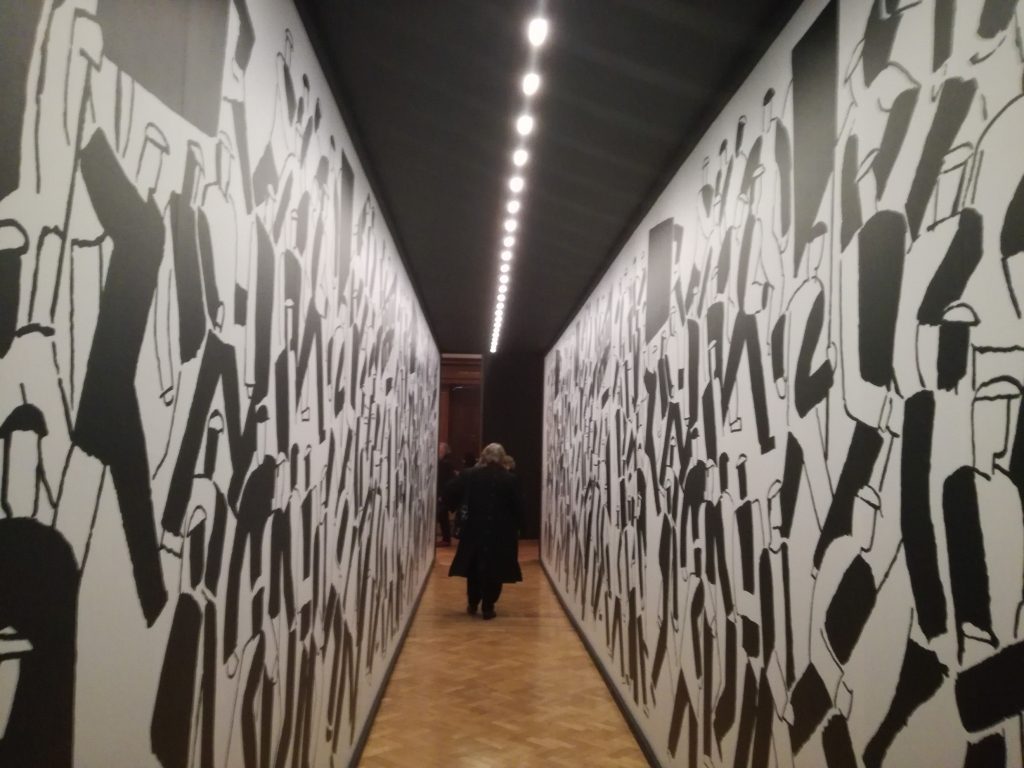
Photo: Tom Michaelson
Artists under Russia’s Tsarist regime operated in a contradictory society. They had access to the most innovative ideas of the avant-garde, but within a context where the vast majority had no access to art. They operated in a society were art was dominated by individual production for individual consumption. The revolution pushed the idea of making art accessible to the masses into a reality. Vladimir Mayakovsky urged artists, “Art must not be concentrated in dead shrines called museums. lt must be spread everywhere – on the streets, in the trams, factories, workshops, and in the workers’ homes.”
It could be argued that this exhibition seeks to return the vibrant living art of the Russian Revolution into a dead shrine – and to seek to ensure it does not spread, gives it an entrance fee of £18!
The exhibition opens with a room titled, ‘Salute the Leader’ which emphasises the cult of leadership. I found it odd that an exhibition on art and revolution had so little about the processes which led up to October – nothing of ‘land, bread and peace’ and the involvement of the masses in the ‘festival of the oppressed and exploited’.
Instead this first room is dominated by images from after the death of Lenin in 1924, when there was a concerted campaign to consolidate Stalin’s position as leader by use of the cult of Lenin. Whilst it is not necessary to be chronological in an exhibition, it seems strange not to start with the experience of revolution. Of the half dozen pre-1924 artworks in this room I felt only the 1919 painting by Isaak Brodsky fitted with the idea ‘salute the leader’.
The curators seem to have a top down view of art. Often the exhibition feels like the ‘oppressed and exploited’ are subjects for the artists, rather than active participants in their own right. This was no aberration as the exhibition organisers referred to the “February revolution”, and the “October coup”. Truly they wish to write the masses out of history – which is bad politics, but is also bad for understanding the artistic works from the time.
The exhibition feels like it wants to put forward a continuity across the period 1917-1932. But neither art nor artists are passive vessels. Art is both used as a reflection of what the artist experiences, and a conduit for change, expressing hopes, fears and aspirations. Those looking at the art – and this exhibition is overwhelmingly visual – interpret it in the light of their own experience. The curators portray much of this exhibition as propaganda, and the way they start the exhibition fits their narrative. However, cultivation of an image, or an exhibition, for public consumption is usually propaganda – but is seldom called out as such.
Public museums and galleries have been part of the process by which states have sought to show their power and influence. They can also seek to represent continuity – often through the creation of ‘traditions’. This exhibition puts post-revolutionary Russian art in that context, but perhaps avoids self-reflection on its own propaganda role as it looks to warn what can happen if you stray too far from the traditional path. The Russian Revolutions – particularly the October revolution – are so far from the traditional paths that it seems, at times, to be a parallel universe.
The leadership of the Bolsheviks did urge artists to use their art as a hammer to shape the new world – and this can be seen literally in images such as Vladimir Mayakovsky’s 1921 stencil Blacksmith.

Blacksmith. Vladimir Mayakovsky, 1921
On other occasions we have the complex and innovative formation of Pavel Filonov’s 1920-21 oil painting Formula of the Petrograd Proletariat which is much more open to interpretation. I read it as showing the process of individual interest and concerns beginning to come together into a collective, moving from being a class in itself, to being a class for itself.
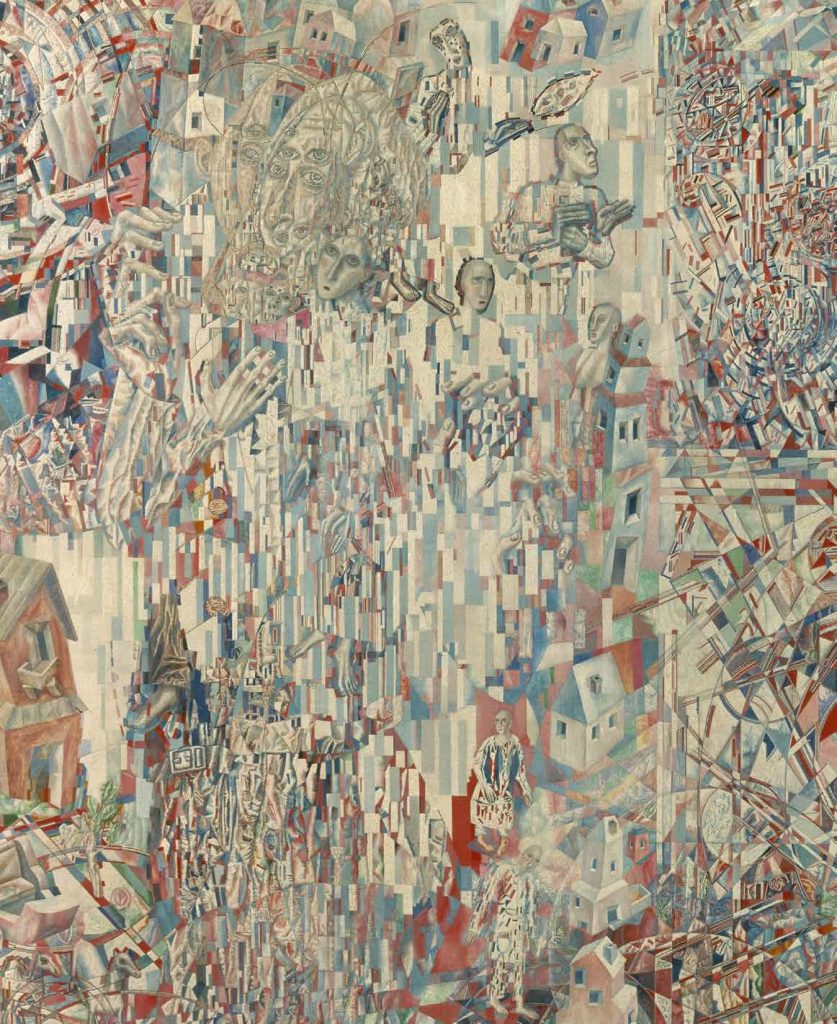
Formula of the Petrograd Proletariat. Pavel Filonov, 1920-21
One thing that was clear in the early years after the revolution was that there was no single state-imposed acceptable art. Debates raged between various schools and styles of art – from the relatively conventional figurative painting of Bronsky to the demands by Constructivists, such as Lyubov Popova, that easel painting be abandoned.
The revolution that saw millions storming the heavens to build a new world created a sense of empowerment that meant people felt ‘any cook should be able to run the state’ (see Boris Kustodiev’s 1920 oil painting The Bolshevik or Konstantin Yuon’s 1921 tempera painting New Planet). Or, as in Alexander Samokhvalov’s 1928 Tram Conductor, that each trolley worker could be a superhero.
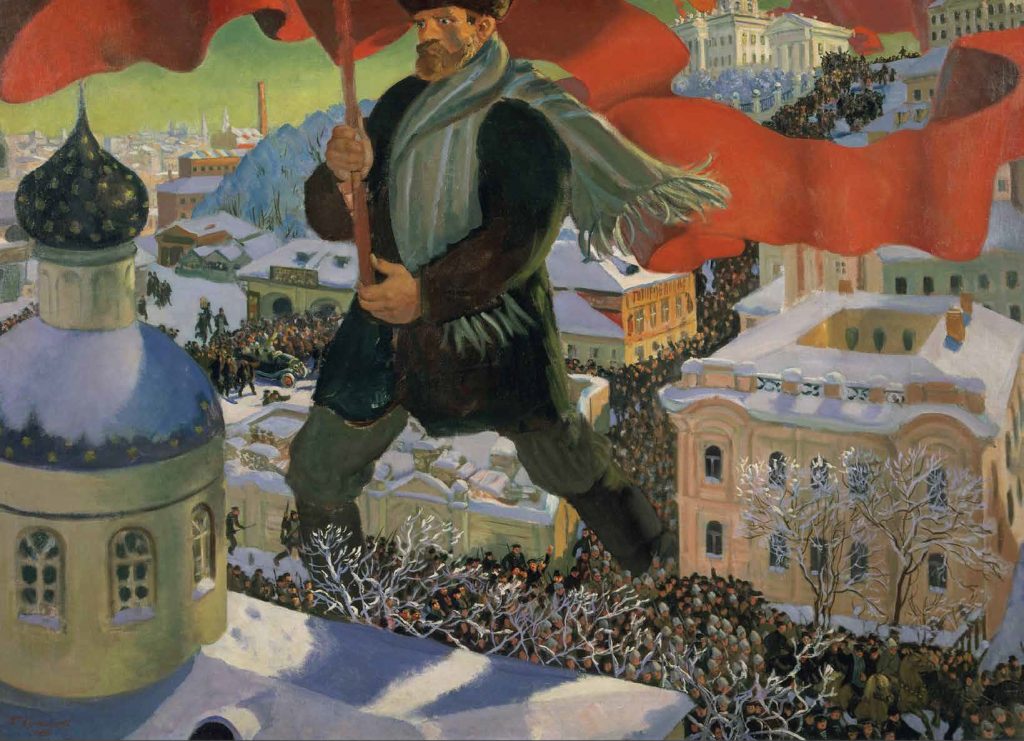
The Bolshevik. Boris Kustodiev, 1920
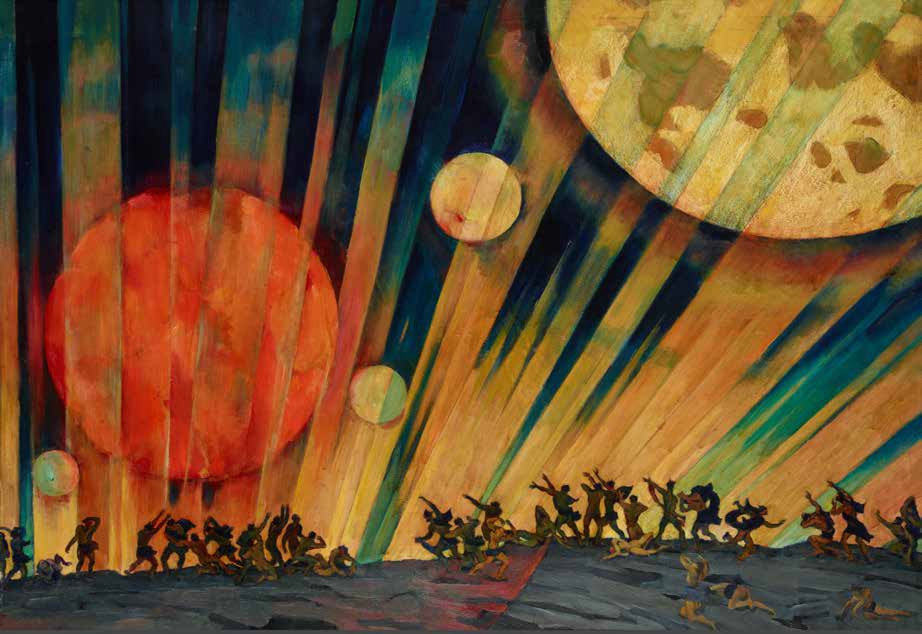
New Planet. Konstantin Yuon, 1921
Even under the conditions of hardship and shortages during the civil war there was a drive towards expansion of literacy and artistic engagement with the wider population. The Commissariat of Enlightenment urged artists to make their work accessible – as in Alexei Radakov’s 1920 poster The Illiterate Man is Like a Blind Man. The relatively new medium of film was seized upon as a route to communication with a mass audience. Monumental art, such as Tatlin’s Tower, was designed, but in a situation of scarcity not constructed.
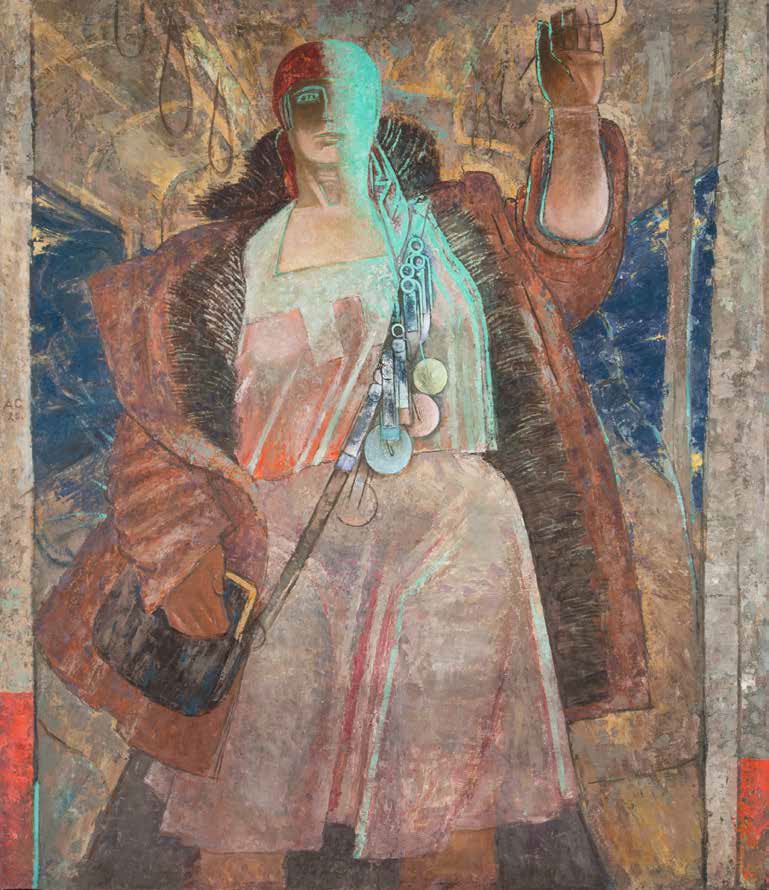
Tram Conductor. Alexander Samokhvalov, 1928
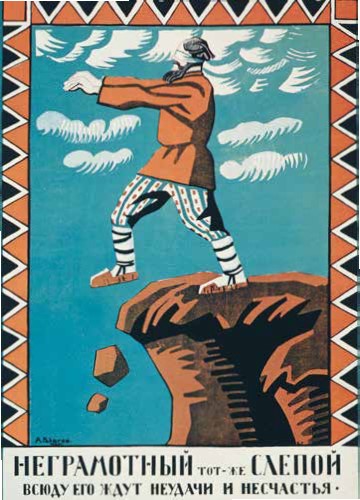
The Illiterate Man is Like a Blind Man. Alexei Radakov, 1920
The images that carry that sense – the fight against the old order, the striving towards liberation, the questioning of what has changed in the world of work (Alexander Deineka, Textile workers, 1927) are in direct contradiction to the images of iconified leaders, depicting superhumans with a steely determination to fulfil this month’s production quota.
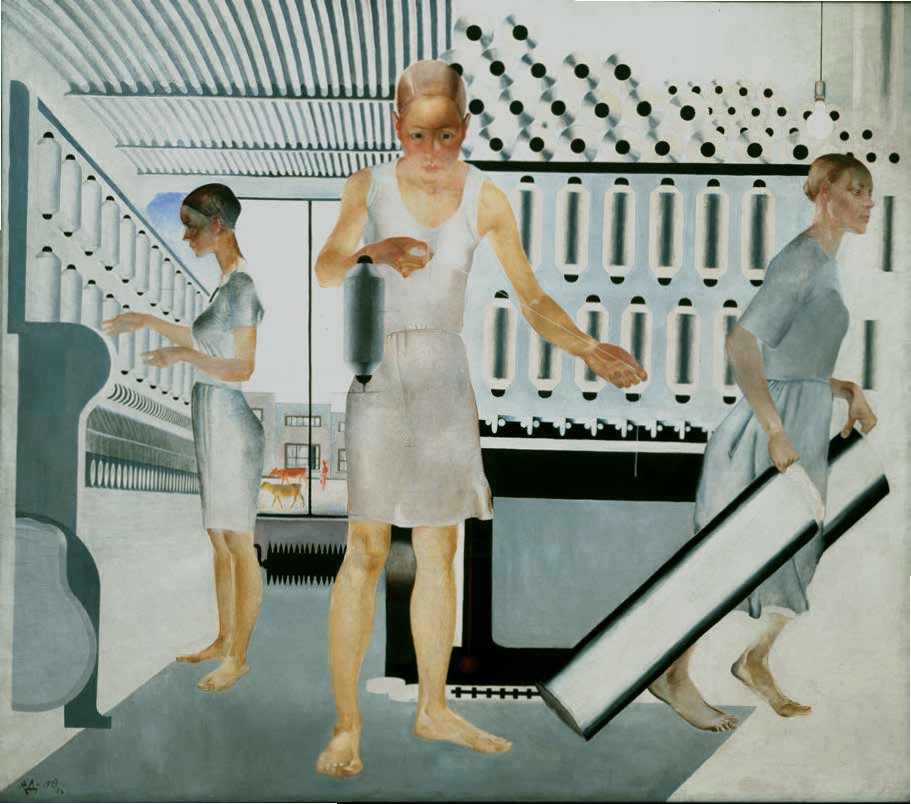
Textile workers. Alexander Deineka, 1927
I feel the way this exhibition is curated muddies the differences. The changes in Russian society after the revolution meant that the unleashing of creativity and involvement during the early years, was replaced by coercion and control.
The changing context of the times is jumbled up by trying to pull together themes that are going in opposite directions. Images urging increased production in the mines of the Donbass, or presenting idyllic scenes of happy and healthy workers conforming to their five year plan become the equivalent of advertising in Western capitalism. The painting of the great leaders become the equivalent of the paintings of the chairman (and man is deliberate) of the board.
The sense of liberation is underplayed by the exhibition’s suggestion of continuity – and yet at the same time the modernity and innovation still forces its way through. The El Lissittzky designed room wouldn’t look out of place in IKEA today. Tatlin’s prototype worker’s bike/plane reminds me of what the eyewitness to the revolution and English author Arthur Ransome said of the Russian revolution – ‘We have seen the flight of the young eagles. Nothing can destroy that fact, even if, later in the day the eagles fall to earth one by one, with broken wings’. Much of the art in this exhibition seeks to embark on that flight to a new world. But it sits alongside artwork which travels in the opposite direction.
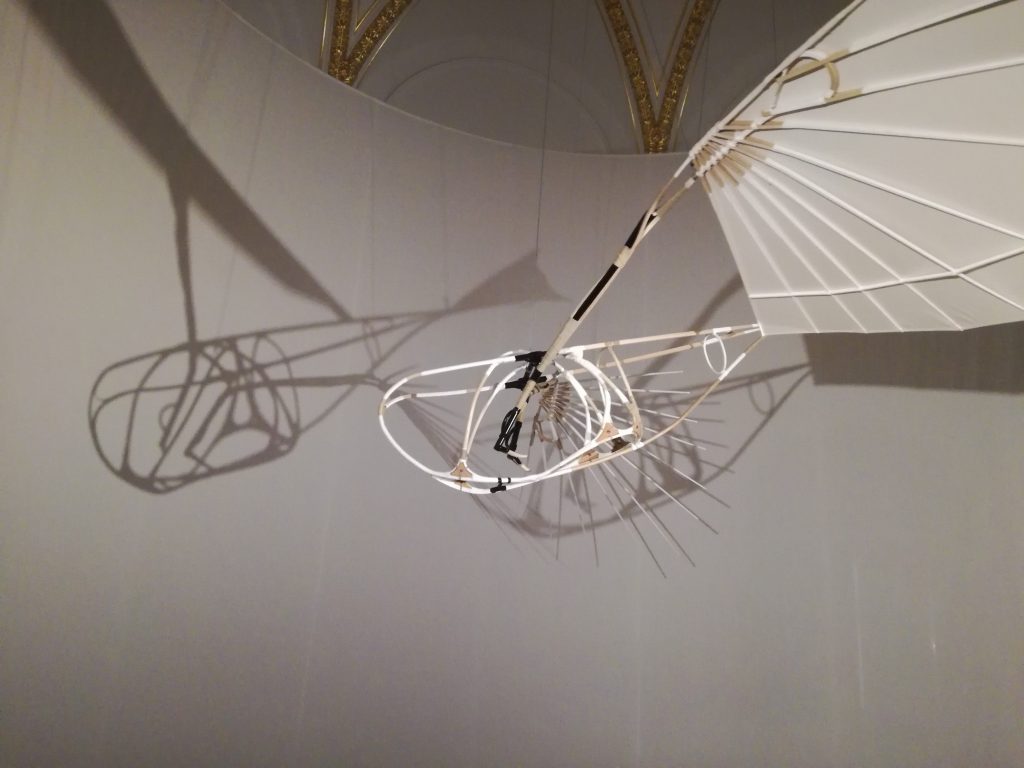
Letatlin. (Vladimir Tatlin’s flying bicycle) Photo: MikeThompson
Revolution: Russian Art 1917-1932 runs at the Royal Academy of Arts in London until 17 April 17th
https://www.royalacademy.org.uk/exhibition/revolution-russian-art











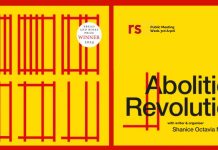


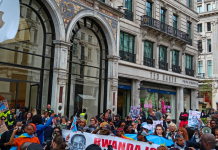





[…] Ο Mike Thompson σχολιάζει την έκθεση στο άρθρο του «The flight of the young eagles – art of the Russian revolution» στην ιστοσελίδα RS21 – revolutionary socialism in the 21st century (https://rs21.org.uk/2017/02/16/the-flight-of-the-young-eagles-art-of-the-russian-revolution/). […]
There is so much to say about this exhibition, that I have left huge areas uncovered. Amongst the gaps… I have said nothing much about: women’s liberation; Malevich; film; purges; avant garde before the revolution; music; poetry; performance art, sport…